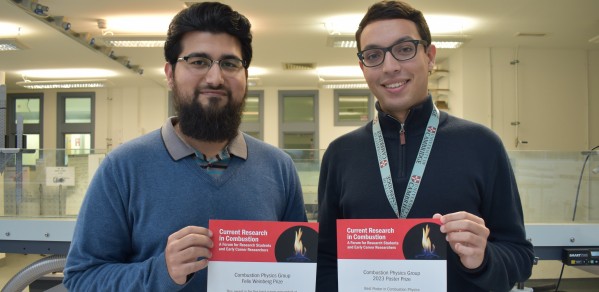
Two PhD students were awarded top prizes at the Institute for Physics (IOP) "Forum for Research Students and Early Career Researchers"
The investigations by both students are important in the context of prediction and validation of models which capture the behaviour and safety of turbulent flames in practical devices such as gas turbines and engines, including in the context of using hydrogen and new fuels
Professor Simone Hochgreb
Hassan Ahmed received the Best Presentation prize for his work:
- H. Ahmed, S. Cant : "Flame Surface Evolution and Machine-Learning Classification of Topology in Turbulent Premixed Flames"
Oussama Chaib received the Best Poster prize for his work:
- O. Chaib, S. Hochgreb, I. Boxx : "Cellular patterns of turbulent premixed hydrogen/methane/air flames"
Hassan Ahmed is studying the topology of turbulent flames using computational methods including Direct Numerical Simulation. Flame topology has a strong influence on the evolution of flame surface area and hence on the overall burning rate. His prize-winning conference presentation explained the theory behind the classification of flame topology into four principal types, and he was able to demonstrate the kinematic relationships between them with the help of a novel machine learning approach.
Hassan holds a Masters degree in Mechanical Engineering from the National University of Sciences and Technology in Pakistan. He is in the second year of his PhD.
Oussama Chaib has been developing methods for the experimental study of turbulent flames of methane-hydrogen mixtures as a fuel. Using a dataset produced by Isaac Boxx at DLR in Germany, he has significantly improved on the computational methods for determining the flame location. His prize-winning research examines the cellular patterns in these same turbulent flames, and how the gradients of OH molecule concentrations (which indicate reaction rate) correlate with the local 2D curvature of the flames. These patterns result from thermodiffusive instabilities associated with the high diffusion coefficients of hydrogen, and have significant implications for the rate of reaction of these turbulent mixtures.
Oussama holds a Masters degree in Aerospace Engineering from the École Centrale (CentraleSupélec) in Paris, and has just finished the second year of his PhD.
The Event
The aim of the Institute for Physics (IOP) "Forum for Research Students and Early Career Researchers" meeting is to provide a forum for contributions on current research in topics relevant to combustion physics and an opportunity to meet other researchers and industrialists. The meeting is sponsored by the IOP and industry and provides industrialists with a broad view of current combustion research and a chance to meet potential recruits in the field.
The meeting includes oral and poster presentations from research students and early careers researchers from leading research groups in the field of Combustion Physics and covers many varied aspects of combustion. The meeting is open to members and non-members of the Institute of Physics and is an interesting and constructive day of presentations and discussions about current research topics in Combustion Physics.

